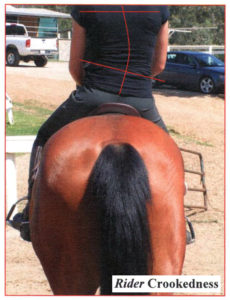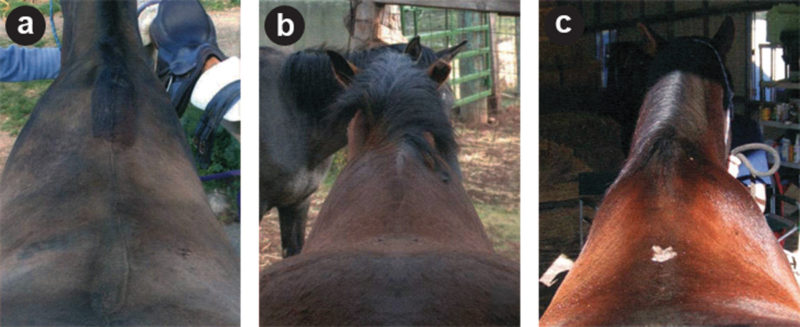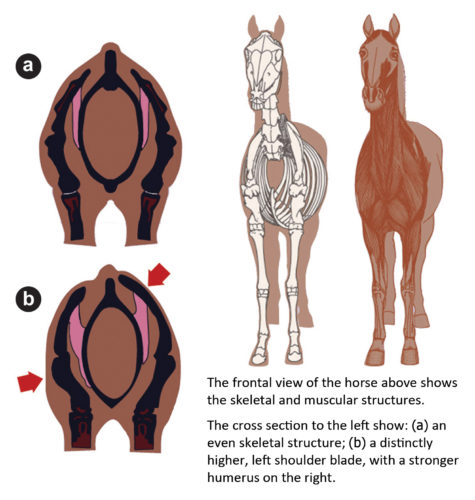Saddle Fit and Asymmetry (Crookedness – Both Horse and Rider)
 I recently came across a client who had an issue that seems not uncommon. Rider balance is a hot topic nowadays, and often when you look at pictures of riders from behind, they are not sitting quite straight (not even top riders!) When I had the saddle on the horse, the tree fit, the panels were level (this particular saddle had Flair panels filled with air), the rider was sitting on both her seat bones apparently in balance, so statically everything looked ok.
I recently came across a client who had an issue that seems not uncommon. Rider balance is a hot topic nowadays, and often when you look at pictures of riders from behind, they are not sitting quite straight (not even top riders!) When I had the saddle on the horse, the tree fit, the panels were level (this particular saddle had Flair panels filled with air), the rider was sitting on both her seat bones apparently in balance, so statically everything looked ok.
Then the horse started moving. The saddle did what it was supposed to do; it stayed in place for the moment, and I was totally satisfied with what I saw – how the saddle was working for the horse and rider. For about 2 minutes. Then the rider started sitting “crooked” in the saddle. 9 out of 10 times the problem begins in the pelvis and legs. Most riders compensate in the lumbar part of their back. Then the upper body – most of the time they have a rotation somewhere in their back, one of their shoulders is higher than the other shoulder and on that side they have their hand higher. The saddle began to obviously twist to the right side the more she rode.
When I took the saddle off, the dust pattern was pretty good, but it seemed that there was a little more dust on the left side, the side where the rider sat “heavier”.
Looking back at years of experience, I tend to think the rider actually has quite some influence on how “straight” the horse is. I have only seen very few horses where the trapezius and the long back muscle (longissimus) were pretty naturally even on both sides.
My question and dilemma: when you want to protect the horse against long term damage, you also have to “help” the rider. But that isn’t our job as saddle ergonomists or saddle fitters. The trainer says the horse is the problem because it is crooked. So do I adjust the panels so the rider is less crooked or leave it as it is? Does the rider have the responsibility to take care of his body so he won’t ‘damage’ his horse?
There are 3 possibilities which the saddle fitter, trainer and rider have to choose from based on the individual circumstances, which will work to fix the problem today – based on the circle of influence to the horse, there is more than just one factor which can influence the horse’s or rider’s physical conformation within a very short time frame – even sometimes from one day to the next!
- The air in these Flair panels can be adjusted to compensate if the rider is ‘structurally uneven. (Wool flocking can also be adjusted to compensate for situations like this).
- If the rider has poor posture then I would suggest that the rider needs to work on his/her straightness by doing various core strengthening exercises. The saddle should never be used as a ‘seat prosthetic’. The saddle is there to protect horse and rider from long term damage and not to be used as a crutch if the rider has no body control.
- If the horse has a larger left shoulder, then the saddle will sit straight in the static fit but in the movement the larger left shoulder will push the saddle to the hollow side (the right side). In this case you need to do an adjustment on the saddle by opening the left tree point of the gullet by ‘x’ cm and supporting the right by the same amount of ‘x’ cm as well. This way the saddle has an opening on the left side and room for the larger left shoulder to come through without pushing the saddle to the right during movement. More ideal would be the asymmetric adjustment to accommodate the larger shoulder but not many saddles can actually be adjusted in this manner, so an even adjustment which ensures the larger shoulder has enough room to move – and a shim under the other, smaller shoulder – will also do the trick.

 There are many theories on what causes asymmetry in horses – it could be genetic, (just like most humans are ‘right-handed’); it could be because of the way the fetus grows in the womb, or it could be a result of the domestication and conditions under which we keep our horses. In my 34+ years of working in this industry, my saddle fit technicians and I have measured and observed upwards of 150,000 horses on pretty much every continent. The majority of them had a definitely stronger muscled left side, with a shoulder blade that was higher and further back than on the right. This becomes very obvious during dynamic movement – pushing the saddle over to the right if it has not been properly adjusted to accommodate this larger shoulder. And as a result, causing the rider to sit out of balance, crookedly, and compensating by somewhat leaning to one side. You’ll notice the left canter lead is much easier. We lead on the left, we mount from the left, we saddle from the left. When horses fight, the defense is to turn the left shoulder to the aggressor. Interesting isn’t it?
There are many theories on what causes asymmetry in horses – it could be genetic, (just like most humans are ‘right-handed’); it could be because of the way the fetus grows in the womb, or it could be a result of the domestication and conditions under which we keep our horses. In my 34+ years of working in this industry, my saddle fit technicians and I have measured and observed upwards of 150,000 horses on pretty much every continent. The majority of them had a definitely stronger muscled left side, with a shoulder blade that was higher and further back than on the right. This becomes very obvious during dynamic movement – pushing the saddle over to the right if it has not been properly adjusted to accommodate this larger shoulder. And as a result, causing the rider to sit out of balance, crookedly, and compensating by somewhat leaning to one side. You’ll notice the left canter lead is much easier. We lead on the left, we mount from the left, we saddle from the left. When horses fight, the defense is to turn the left shoulder to the aggressor. Interesting isn’t it?
So in this case, because this saddle happened to be one with a non-asymmetrically adjustable tree, with Flair panels, we had to go with plan B – the tree was adjusted evenly on both sides to fit the larger shoulder, and the rider put a gel pad under the saddle with a shim to accommodate the smaller side. The Flair panels were also adjusted to accommodate the more muscled side of the horse. And Voilà! The rider kept her position straight even after riding a normal lesson. Horse happy. Rider happy.
My job was done here.
